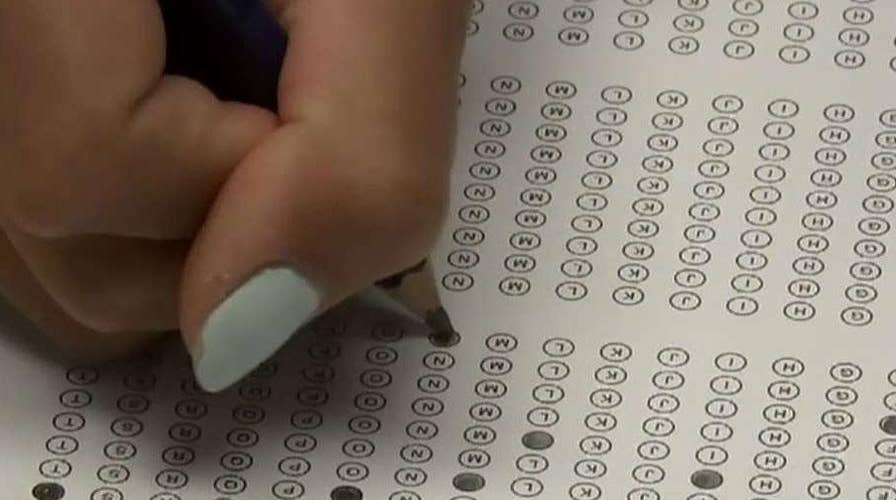SAT to give students 'adversity score' to capture social and economic background
SAT to give students 'adversity score' to capture social and economic background
Rather than reducing anxiety around standardized testing following the recent college admissions scandal, in which wealthy parents are accused to paying bribes to get their children into selective colleges, the College Board has managed to ratchet up anxiety with a so-called “adversity score.”
Beginning next year, the score – part of the College Board's Environmental Context Dashboard – will be assigned to every student who takes the SAT exam that many colleges use to help determine which students they admit.
As The Wall Street Journal first reported: “The new number … is calculated using 15 factors including the crime rate and poverty levels from the student’s high school and neighborhood. Students won’t be told the scores, but colleges will see the numbers when reviewing their applications.”
SAT TO USE 'ADVERSITY SCORE' FOR STUDENTS APPLYING TO COLLEGE
The goal of the scores is to increase socioeconomic diversity in colleges by giving students credit for overcoming great obstacles they face in their lives. It does not raise SAT scores, but rather supplements them.
The measurement of overcoming adversity has been tested by 50 colleges since last year and the test group will expand to 150 schools in the fall, before being used for all SAT test-takers starting in 2020.
Many parents and students are rightfully worried after hearing about this new tool that colleges and universities will use to determine who gets admitted.
Does this “score” that a student has no control over somehow negate his or her hard work? Does it lend false confidence to a modest scorer from a lower income background?
For students who are fortunate to have two parents who attended college – or who grow up in a safe, affluent, or educated neighborhood – has the bar for achievement just been raised to an unreachable height?
Colleges have been championing students who come from more challenging backgrounds for years, and the schools have far better information – through application material submitted by prospective students – to assess adversity than an oversimplified score.
The new College Board measurement of adversity is misguided for three reasons:
First, the adversity measurement is redundant.
Colleges have been championing students who come from more challenging backgrounds for years, and the schools have far better information – through application material submitted by prospective students – to assess adversity than an oversimplified score.
As one example, 15.8 percent of Harvard’s Class of 2020 is “first generation,” or the first in one’s family to attend college. That number increased to 16.3 percent for the Class of 2021, and increased again to 17 percent for the Class of 2022, even while admitted first-generation students reported average SAT scores of 2,118 (using the old SAT 2,400 scale) and students who were not first- generation reported averaging 2,257.
This suggests that Harvard, as a proxy for selective universities, has long been comfortable assessing a student’s achievements, SAT scores included, in the context of the student’s background.
In fact, students with families that earn less than $40,000 per year had an average SAT score of 2,157, while freshmen with families making between $250,000 and $500,000 had an average score of 2,280.
Again, this suggests that Harvard is looking at achievements in the context of access, which admissions officials can better gauge on an individual level – rather than using less specific demographics of school and neighborhood – from a student’s application, including place of birth, parents’ education level (including where they studied), the all-important essays, teacher and counselor recommendations, high school student activities lists, and more.
Second, there is a self-reporting loophole.
The adversity score will be made available on official score reports to colleges, but not to students. But most selective colleges now allow students to self-report SAT scores on applications, to help families avoid the hefty fees of official SAT score reports.
These students are required to send official score reports only upon acceptance, and only if they plan to attend a college. If you are worried about being deemed “low adversity,” why wouldn’t you just self-report on your application and avoid your achievements being caveated by the adversity score?
Third, the College Board is fairly bad at standardizing qualitative measures.
The SAT Essay was redesigned in 2016 alongside the entire SAT to assign a standardized score for analytical writing skills. How did it go? Scores were wildly inconsistent and now, three years later, the majority of selective colleges have stopped requiring the essay.
While assessing adversity is a somewhat different qualitative challenge, one must ask: How will an adversity index be standardized from California to Maine to Shanghai?
If the “family environment” factors – roughly a third of the 15 factors determining adversity – are gathered from the excruciatingly long survey students have to complete while registering for the SAT, what ensures their accuracy?
CLICK HERE TO GET THE FOX NEWS APP
What about cases where students abstain from answering a personal question, such one’s family income? What if the cost of living is drastically different from one region to another? These are gray areas. Maybe the College Board should stick to questions that can be answered by shading in a bubble.
Given the excellent work that colleges are doing in considering specific indicators of socioeconomic context and making room for more applicants who have overcome challenges, the benefit of any adversity index is limited. The downside, however – a feeling of “never good enough” among some students not judged to have faced great adversity – is dangerous.

